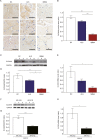Impaired muscle uptake of creatine in spinal and bulbar muscular atrophy
- PMID: 27386502
- PMCID: PMC4931718
- DOI: 10.1002/acn3.324
Impaired muscle uptake of creatine in spinal and bulbar muscular atrophy
Abstract
Objective: The aim of this study was to explore the pathomechanism underlying the reduction of serum creatinine (Cr) concentrations in spinal and bulbar muscular atrophy (SBMA).
Methods: We evaluated blood chemistries, motor function, and muscle mass measured by dual-energy X-ray absorptiometry in male subjects with SBMA (n = 65), amyotrophic lateral sclerosis (ALS; n = 27), and healthy controls (n = 25). We also examined the intramuscular concentrations of creatine, a precursor of Cr, as well as the protein and mRNA expression levels of the creatine transporter (SLC6A8) in autopsy specimens derived from subjects who had SBMA and ALS and disease controls. Furthermore, we measured the mRNA expression levels of SLC6A8 in cultured muscle cells (C2C12) transfected with the polyglutamine-expanded androgen receptor (AR-97Q).
Results: Serum Cr concentrations were significantly lower in subjects with SBMA than in those with ALS (P < 0.001), despite similar muscle mass values. Intramuscular creatine concentrations were also lower in with the autopsied specimen of SBMA subjects than in those with ALS subjects (P = 0.018). Moreover, the protein and mRNA expression levels of muscle SLC6A8 were suppressed in subjects with SBMA. The mRNA levels of SLC6A8 were also suppressed in C2C12 cells bearing AR-97Q.
Interpretation: These results suggest that low serum Cr concentration in subjects with SBMA is caused by impaired muscle uptake of creatine in addition to being caused by neurogenic atrophy. Given that creatine serves as an energy source in skeletal muscle, increasing muscle creatine uptake is a possible therapeutic approach for treating SBMA.
Figures



Similar articles
-
Treatment with Creatine Monohydrate in Spinal and Bulbar Muscular Atrophy: Protocol for a Randomized, Double-Blind, Placebo-Controlled Trial.JMIR Res Protoc. 2018 Mar 5;7(3):e69. doi: 10.2196/resprot.8655. JMIR Res Protoc. 2018. PMID: 29506970 Free PMC article.
-
Decreased Peak Expiratory Flow Associated with Muscle Fiber-Type Switching in Spinal and Bulbar Muscular Atrophy.PLoS One. 2016 Dec 22;11(12):e0168846. doi: 10.1371/journal.pone.0168846. eCollection 2016. PLoS One. 2016. PMID: 28005993 Free PMC article.
-
Increased mitophagy in the skeletal muscle of spinal and bulbar muscular atrophy patients.Hum Mol Genet. 2017 Mar 15;26(6):1087-1103. doi: 10.1093/hmg/ddx019. Hum Mol Genet. 2017. PMID: 28087734 Free PMC article.
-
[Molecular pathogenesis of motor neuron diseases].Nihon Shinkei Seishin Yakurigaku Zasshi. 2001 Feb;21(1):21-25. Nihon Shinkei Seishin Yakurigaku Zasshi. 2001. PMID: 11400322 Review. Japanese.
-
Pathogenesis and molecular targeted therapy of spinal and bulbar muscular atrophy.Neuropathol Appl Neurobiol. 2007 Apr;33(2):135-51. doi: 10.1111/j.1365-2990.2007.00830.x. Neuropathol Appl Neurobiol. 2007. PMID: 17359355 Review.
Cited by
-
TDP-43 regulates early-phase insulin secretion via CaV1.2-mediated exocytosis in islets.J Clin Invest. 2019 Jul 29;129(9):3578-3593. doi: 10.1172/JCI124481. eCollection 2019 Jul 29. J Clin Invest. 2019. PMID: 31355778 Free PMC article.
-
Beyond motor neurons: expanding the clinical spectrum in Kennedy's disease.J Neurol Neurosurg Psychiatry. 2018 Aug;89(8):808-812. doi: 10.1136/jnnp-2017-316961. Epub 2018 Jan 20. J Neurol Neurosurg Psychiatry. 2018. PMID: 29353237 Free PMC article. Review.
-
The value of serum creatinine as biomarker of disease progression in spinal and bulbar muscular atrophy (SBMA).Sci Rep. 2023 Oct 12;13(1):17311. doi: 10.1038/s41598-023-44419-6. Sci Rep. 2023. PMID: 37828349 Free PMC article.
-
Treatment with Creatine Monohydrate in Spinal and Bulbar Muscular Atrophy: Protocol for a Randomized, Double-Blind, Placebo-Controlled Trial.JMIR Res Protoc. 2018 Mar 5;7(3):e69. doi: 10.2196/resprot.8655. JMIR Res Protoc. 2018. PMID: 29506970 Free PMC article.
-
Biomarkers of Spinal and Bulbar Muscle Atrophy (SBMA): A Comprehensive Review.Front Neurol. 2018 Oct 10;9:844. doi: 10.3389/fneur.2018.00844. eCollection 2018. Front Neurol. 2018. PMID: 30364135 Free PMC article. Review.
References
-
- Kennedy WR, Alter M, Sung JH. Progressive proximal spinal and bulbar muscular atrophy of late onset. A sex‐linked recessive trait. Neurology 1968. Jul;18:671–680. - PubMed
-
- Sobue G, Hashizume Y, Mukai E, et al. X‐linked recessive bulbospinal neuronopathy. A clinicopathological study. Brain 1989;112 (Pt 1):209–232. - PubMed
-
- Fischbeck KH. Kennedy disease. J Inherit Metab Dis 1997. Jun;20:152–158. - PubMed
-
- Katsuno M, Tanaka F, Adachi H, et al. Pathogenesis and therapy of spinal and bulbar muscular atrophy (SBMA). Prog Neurobiol 2012;99:246–256. - PubMed
-
- Hashizume A, Katsuno M, Banno H, et al. Difference in chronological changes of outcome measures between untreated and placebo‐treated patients of spinal and bulbar muscular atrophy. J Neurol 2012;259:712–719. - PubMed
LinkOut - more resources
Full Text Sources
Other Literature Sources
Research Materials
Miscellaneous

